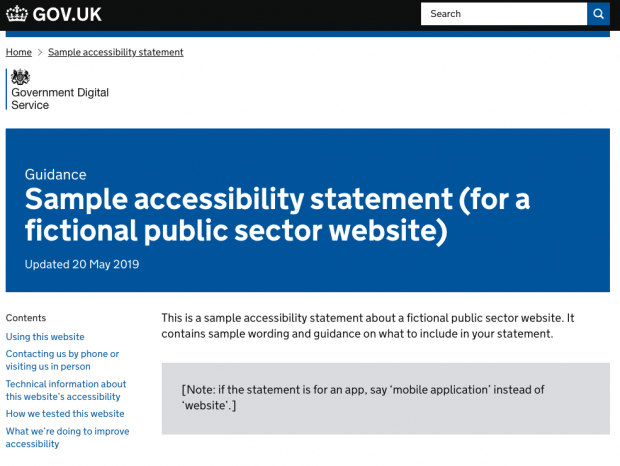
New regulations mean that public sector websites and mobile apps will soon have a legal duty to meet accessibility requirements. You’ll need to:
- carry out an evaluation of how accessible your websites and mobile apps are
- fix accessibility problems (when you’re required to do so)
- publish a statement saying what’s accessible, what’s not – and why
You’ll need to do this by 23 September 2019 for newer websites (those published later than 22 September 2018). There are later deadlines for older websites and mobile apps.
We’ve blogged about this a few times over the past months; here’s the latest on what’s happening.
Updated guidance on meeting accessibility requirements
We’ve updated the guidance on making your public sector website or app accessible.
We have:
- split the information that was there into two guides – one that’s focused on understanding your obligations and one that’s focused on the practicalities of making a plan to identify and fix accessibility problems
- added more detail on evaluating your website or app so you can publish an accessibility statement saying how accessible it is
You will find a link to a sample accessibility statement you can use to help you write your own. Thanks to colleagues at AbilityNet, JISC, Kent County Council, Nomensa, the University of Kent and others for their help putting this together.

Monitoring and enforcement
We’ve had some questions about how compliance will be monitored and how the regulations will be enforced.
A central monitoring team at GDS will assess a sample of public sector websites and apps. The aim of monitoring is to help and encourage the public sector to make timely improvements to websites and apps – making them accessible to as many people as possible and avoiding the need for enforcement.
The sample will be chosen based on a number of factors, including:
- how many people risk being excluded
- where there are known or suspected problems (for example, because there have been complaints)
If the monitoring team discovers accessibility problems with a website or app in the sample, they will notify the website or app owner and signpost them to support to help resolve the problems.
The monitoring team will be overseen by the Cabinet Office and supported by an independent panel of stakeholders.
Assuring compliance with the regulations will, in part, fall within the existing enforcement powers of the Equality Advisory & Support Service, the Equality and Human Rights Commission and the Equality Commission for Northern Ireland.
GDS – acting on behalf of the Minister for the Cabinet Office – will assess whether accessibility statements meet legal requirements.
The Equality Advisory & Support Service provides individuals with information about discrimination and their rights as users of public services.
We’ll publish further information on monitoring and enforcement processes in the future.
What’s next
Most public sector organisations will want to consider getting help from an external accessibility expert to evaluate their websites and apps. But for organisations that genuinely can’t afford to do that, we’re working on a simple approach to self-evaluation. We will aim to publish this soon.


32 comments
Comment by Nordin Zaoui posted on
We’ve taken significant steps towards achieving compliance with WCAG 2.1 AA, ensuring that the main structure of our website meets this standard. However we have a large number of documents published on the website since 1998 which have not been checked for accessibility and will constitute a significant disproportionate burden to address retrospectively.
We'd appreciate clarification on the following:
• Are we right to assume that the accessibility requirements regarding documents will apply to publications published from the 23rd Sep 2019?
• Can we apply exemption on the grounds of disproportionate burden on the organisation to retrospectively alter a significant volume of documents?
Your advice would be appreciated.
Comment by Joseph posted on
Hi Nordin
On publications, before you begin the process of disproportionate burden, it is important to note that under Part 1, Regulation 4(2) notes that there are some exceptions for content within websites - Source: http://www.legislation.gov.uk/uksi/2018/952/introduction/made
Some of these exceptions may be applicable to the publications you mentioned.
We have guidance on disproportionate burden here: https://www.gov.uk/guidance/accessibility-requirements-for-public-sector-websites-and-apps.
Generally when making your assessment, you need to think about:
· your organisation’s size and resources
· the nature of your organisation (for example, do you have services aimed at people who are likely to have a disability?)
· how much making things accessible would cost and the impact that would have on your organisation
· how much users with a disability would benefit from you making things accessible
Regarding your first clarification on documents, any content on a website/webpage that was published on or after 23 September 2018 will need to meet accessibility standards and publish an accessibility statement by 23 September 2019.
Any content on a website/webpage that were published before 23 September 2018 need to comply with the regulations by 23 September 2020.
Comment by Alec posted on
Hi there,
Is there any update on the guidance?
Also, say you have some content on your website that isn't accessible, you mention it in your accessibility statement (as well as why and what you're doing to fix this), does this mean you're covered legally?
Comment by Andy posted on
2 Questions and apologies if they are in the wrong place. If so could someone direct me to the correct one. Thanks.
How do the regulations apply to the providers of hosted systems we are procuring that are accessed via a browser?
When putting togehter an ITT how should the WCAG requirement be worded for the above scenario?
Comment by Joseph Jones, GDS posted on
Hi Andy
On your first question, your organisation will need to work with your providers to make sure all sites meet the 2018 regulations: https://www.gov.uk/guidance/accessibility-requirements-for-public-sector-websites-and-apps
Intranets and extranets are exempt until they undergo a substantial revision after 23rd September 2019. But it is your responsibility to ensure, that going forward, any procured systems are accessible.
Invitations to Tender should include requirements about meeting WCAG 2.1 AA and publishing Accessibility Statements for websites and mobile apps. Suppliers could be asked to provide evidence of meeting the standard in previous projects, their approach to accessibility testing, and integration of accessibility testing in the software release process.
Comment by Adedotun posted on
This is very nice.
Comment by Peter posted on
What is your definition of 'intranet'?
Is it any browser operated system for staff?
What about if it's externally hosted/supplied?
Thankss
Comment by Joseph posted on
Hi Peter
Under Regulation 4(3)(b) of the Public Sector Bodies (Websites and Mobile Applications) Accessibility Regulations 2018 states that “extranets and intranets” are websites that are only available for a closed group of people and not to the general public; Source: http://www.legislation.gov.uk/uksi/2018/952/introduction/made
If your intranet/extranet is outsourced or procured, you’ll need to work together to make sure your website meets the 2018 regulations: https://www.gov.uk/guidance/accessibility-requirements-for-public-sector-websites-and-apps
Comment by Peter posted on
Thanks Joseph
There's still some ambiguity here.
Is it any browser operated system for staff?
You could have a time recording or finance system for all staff that is operated via a browser. Is that in scope? (as an example)
Comment by Alec posted on
"But for organisations that genuinely can’t afford to do that, we’re working on a simple approach to self-evaluation. We will aim to publish this soon."
Any idea when this will be available?
Comment by GDS posted on
Hi Alec,
This guidance should be available before the end of the month.
All the best,
GDS
Comment by Alec posted on
Thanks for the reply - look forward to seeing the guidance.
Comment by Alec posted on
Hi there,
Is there any update on the guidance?
Comment by Alec posted on
Also, say you have some content on your website that isn't accessible, you mention it in your accessibility statement (as well as why and what you're doing to fix this), does this mean you're covered legally?
Comment by Charlotte posted on
Stupid question - Where IS the example accessibility statement?
Comment by GDS posted on
Hi Charlotte,
You can find the sample accessibility statement on this page: https://www.gov.uk/government/publications/sample-accessibility-statement.
All the best,
GDS
Comment by Karen Winter posted on
Please could you clarify if this includes Parish Council websites?
Comment by Anthony Ilona, GDS posted on
Hi Darren,
Regulation 4 (2)g makes specific reference to intranets and extranets.
Comment by Tim White B&NES posted on
Hi
Does this extend to websites without a .gov.uk domain too? We operate a number of commercial sites with a .co.uk. Are they in scope for this too?
Comment by Anthony Ilona, GDS posted on
Hi Tim,
It’s more about ownership of the site and its content than the domain name when considering legal compliance. According to the regulations, if third party content is neither funded nor developed by the public sector body concerned nor under its control, it is exempt.
Comment by Stephen Burke posted on
Hi
Can you clarify the guidance please.
If the website was built before 23/09/2018, does the accessibility statement still need to be added to the website before 23/09/2019? Or should we ensure it is added before 23/09/2020?
So far we have been working on the proviso that the accessibility statement should be added to the website by 23/09/2019 but that the work to meet the standards should be complete by 23/09/2020.
Comment by Tony Ilona, GDS posted on
Hi Stephen,
The regulations state that existing websites (those published before 23 September 2018) must meet the required accessibility standard AND display a compliant accessibility statement on and after 23 September 2020.
Newly published websites (those published on and after 23 September 2018) are required to meet the same terms by 22 September 2019.
Comment by Charlotte posted on
Does the EU directive cover Universities? A definitive answer from government would be AWESOME.
Comment by Anthony Ilona, GDS posted on
Hi Charlotte,
While Universities are generally considered to be in scope of the regulations, we recommend that you seek professional advice for a definitive answer.
Comment by Emma posted on
Your answer to this question has me confussed?
'While Universities are generally considered to be in scope of the regulations, we recommend that you seek professional advice for a definitive answer'
GDS have set these deadlines, how can there be any questions that you can't answer? Who are we supposed to ask for definitive answers if GDS themselves can't answer questions?
Comment by chris_debian posted on
Is this just public facing, or internal government websites, such as intranets?
Thanks,
Chris
Comment by Anthony Ilona, GDS posted on
Hi Chris,
There are requirements in the regulations that apply to non public-facing websites such as intranets and extranets.
Comment by chris_debian posted on
Many thanks for the clarification, Anthony.
Chris.
Comment by Darren posted on
Which requirements specifically apply to Intranets and Extranets?
Comment by Jason posted on
Are you sure? Section 4 (2) (g) states "These Regulations do not apply to the following content of a website or mobile application
of a public sector body...content of extranets and intranets published before 23rd September 2019, until such websites undergo a substantial revision;
It goes on to say;
(3) In this regulation—
(b) “extranets and intranets” means a website that is only available for a closed group of people and not to the general public;
Comment by Alex posted on
Further to this, does it mean that any new content published on a intranet/extranet from 23 September onwards needs to be fully accessible?
Comment by agtrier posted on
Good to see that GOV.UK is implementing the new EU accessibility directive. In fact, that's good news for everybody!